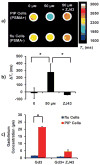Synthesis and Evaluation of Gd(III) -Based Magnetic Resonance Contrast Agents for Molecular Imaging of Prostate-Specific Membrane Antigen
- PMID: 26212031
- PMCID: PMC4729199
- DOI: 10.1002/anie.201503417
Synthesis and Evaluation of Gd(III) -Based Magnetic Resonance Contrast Agents for Molecular Imaging of Prostate-Specific Membrane Antigen
Abstract
Magnetic resonance (MR) imaging is advantageous because it concurrently provides anatomic, functional, and molecular information. MR molecular imaging can combine the high spatial resolution of this established clinical modality with molecular profiling in vivo. However, as a result of the intrinsically low sensitivity of MR imaging, high local concentrations of biological targets are required to generate discernable MR contrast. We hypothesize that the prostate-specific membrane antigen (PSMA), an attractive target for imaging and therapy of prostate cancer, could serve as a suitable biomarker for MR-based molecular imaging. We have synthesized three new high-affinity, low-molecular-weight Gd(III) -based PSMA-targeted contrast agents containing one to three Gd(III) chelates per molecule. We evaluated the relaxometric properties of these agents in solution, in prostate cancer cells, and in an in vivo experimental model to demonstrate the feasibility of PSMA-based MR molecular imaging.
Keywords: cancer; gadolinium; imaging agents; magnetic resonance imaging.
© 2015 WILEY-VCH Verlag GmbH & Co. KGaA, Weinheim.
Figures



References
-
- Caravan P. Acc Chem Res. 2009;42:851–862. - PubMed
- Huang CH, Tsourkas A. Curr Top Med Chem. 2013;13:411–421. - PMC - PubMed
- Lanza GM, Winter PM, Caruthers SD, Morawski AM, Schmieder AH, Crowder KC, Wickline SA. J Nucl Cardiol. 2004;11:733–743. - PubMed
- Pais A, Gunanathan C, Margalit R, Biton IE, Yosepovich A, Milstein D, Degani H. Cancer Res. 2011;71:7387– 7397. - PMC - PubMed
MeSH terms
Substances
Grants and funding
LinkOut - more resources
Full Text Sources
Other Literature Sources
Medical
Miscellaneous

